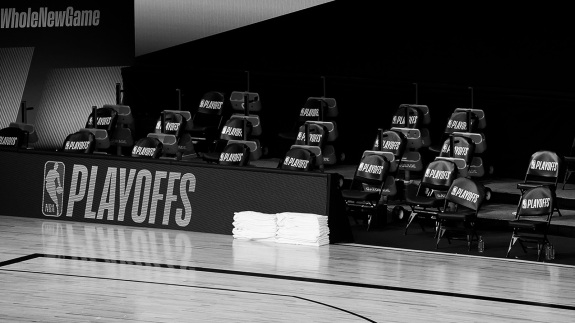Crédito: fuente
The Milwaukee Bucks’ decision not to take the court for their playoff game Wednesday reverberated quickly across the sports world. Their protest against the police shooting of a Black man, Jacob Blake, in Kenosha, Wisconsin, was joined by other teams in the NBA as well as three other leagues: WNBA players called off their Wednesday night games; three MLB games were postponed, with the Milwaukee Brewers the first to decide against playing their home game; and five MLS matches were shelved.
NBA players in the bubble, the league’s Orlando-based hub for the 2020 playoffs (largely sealed off from the rest of society to prevent coronavirus infections), held a meeting late Wednesday to talk about what exactly comes next for the playoffs, if anything. The remaining teams were polled on their initial preference, and the Lakers and Clippers voted to end the season. The players will meet again Thursday at 11 a.m. Eastern, according to ESPN’s Malika Andrews and Adrian Wojnarowski, at the same time as a meeting of the NBA’s Board of Governors. No NBA games are expected to be played Thursday.
Amid efforts across sports to return to play during the coronavirus pandemic, the Milwaukee-led strike represents the most significant act of demonstration during a summer full of athletes blurring the line between sports and politics. The NBA gave Black Lives Matter signs prominent placement on courts in Orlando, and players were able to put messages on the backs of their jerseys (selecting from a pre-approved list). But some players had begun to wonder whether the presence of slogans around the broadcasts had really helped the movement, or if the games merely served to distract from the larger message.
“We shouldn’t have came to this damn place, to be honest,” Bucks guard George Hill told reporters on Monday. “Coming here just took all the focal points off what the issues are. … We’re down here playing in the bubble to do these things for social justice and all that. To see it all still going on and we’re just playing the games like it’s nothing, it’s just a really messed up situation right now.”
That such frustrations have come to a head this week, in the wake of Blake’s shooting, isn’t surprising. But that they would lead to a mass strike is historic. A few members of the Boston Celtics sat out an exhibition game in 1961 over the racist treatment of Black players at the team’s hotel. NBA All-Stars also staged a strike before tipoff in 1964, fighting for better working conditions for all players — a momentous event in the history of the sports labor movement. But we’ve never quite seen so many players refuse to take the court in solidarity with a social movement that extends far beyond sports.
The closest analog might be when Roberto Clemente and the Pittsburgh Pirates voted not to play on opening day in 1968 — the day of Martin Luther King Jr.’s funeral — and other clubs eventually followed suit. The Dodgers, who had broken the league’s color barrier by signing Jackie Robinson in 1947, were the last holdouts, and the team’s front office figured King’s funeral would be over by the time its game began. But the club had no choice but to eventually cave when the team they were slated to host, the Philadelphia Phillies, said they would rather forfeit than take the field. It was another case of a league’s Black players having to band together and threaten a boycott in order to protest injustice.
But back to 2020. The Milwaukee Bucks, of all the teams in all the leagues, might seem like an odd place to find the spark for such a historic strike, but they’re not — particularly for a protest about racial justice. According to The Institute for Diversity and Ethics in Sport (TIDES), 83.1 percent of NBA players in the 2019-20 season are people of color, including 74.2 percent who are Black or African American. Simply put, no other league has such a large share of players who can identify so strongly with the horror of police violence against Black Americans.
“It could be me,” said Portland Trail Blazers star Damian Lillard (among others) in a video released after Minneapolis police killed George Floyd in May.
And the Bucks have been as vocal as any NBA team on the subject of police brutality — Milwaukee police apologized to Bucks guard Sterling Brown in 2018 after officers took the player to the ground and tased him over a parking dispute. Plus, Kenosha is just 39 miles south of Milwaukee, essentially putting the incident in the club’s backyard. The Bucks’ players used their time off the court Wednesday to work for change, holding a conference call from their locker room with the Wisconsin attorney general and lieutenant governor, asking what could be done on the issue of police reform in the state.
The strike, four years after Colin Kaepernick kneeled during the national anthem for the first time to draw attention to racial injustice, comes as white Americans’ support for Black Lives Matter protests has waned. The poll numbers on the question, which surged after Floyd’s death, have fallen in recent months — closer to where they were before the Floyd protests.
But don’t expect a widespread backlash to the strike among NBA fans. The players’ commitment to racial justice is helped by their sport’s very liberal fan base. According to a poll we conducted in partnership with the market research firm Ipsos in early May, basketball is one of the sports with the highest share of “major” or “casual” fans identifying as Democrats. We found that only soccer fans (with nearly 64 percent identifying as Democrats) leaned more to the left than basketball fans (of whom nearly 60 percent were Democrats).
Basketball has a left-leaning fan base
Two-party share of self-described major or casual fans who identified as either Democrats or Republicans in a FiveThirtyEight/Ipsos poll
| Share of two-Party Fan Support | ||
|---|---|---|
| Sport | Democrats | Republicans |
| Soccer | 63.9% | 36.1% |
| Basketball | 59.7 | 40.3 |
| Football | 49.5 | 50.5 |
| Baseball | 44.2 | 55.8 |
| Hockey | 38.4 | 61.6 |
| Golf | 37.4 | 62.6 |
| NASCAR | 32.6 | 67.4 |
Our previous research has also shown the NBA to have the most left-leaning fandom of any major men’s pro league. So NBA fans will probably continue to be sympathetic to the players’ cause, by and large — which may have served to insulate the league from the kind of political backlash the NFL faced after players took a knee during the national anthem to protest police violence, for instance.
Over the past decade, the NBA has increasingly been at the forefront of social consciousness among sports leagues. According to ESPN’s Ramona Shelburne, the Los Angeles Clippers seriously considered boycotting Game 5 of their 2014 first-round playoff series after recordings emerged of team owner Donald Sterling making racist comments. But they ultimately decided to play — in the words of Blake Griffin, “we haven’t been playing for [Sterling] in the first place.”
That near-boycott played a role in Adam Silver’s decision to ban Sterling from the league, a pivotal moment not just in Silver’s stewardship as commissioner, but also in the league’s evolution as a force for progressive social change. After unarmed Black teenager Trayvon Martin was killed in Florida a few years earlier, members of the Miami Heat had worn hoodies in solidarity. Many stars also wore “I Can’t Breathe” shirts after New York police killed Eric Garner in 2014.
More recently, NBA players were fixtures at the protests after Floyd’s death over the summer. The ability to continue those protests was top of mind as players were debating whether to enter the bubble, a closed environment, for several months of playoff games. Kyrie Irving of the Brooklyn Nets led a June call with fellow players, asking whether a return to play would distract from the message of the Black Lives Matter protests going on outside the bubble.
The refusal to play on Wednesday could be seen as an extension of the same philosophical debate: Is more good being done by playing — seen by some as a distraction from the societal issues at hand — but being visible on TV every night, or protesting and staying focused on the larger message but having less of a traditional media platform? The NBA will have to face that question again on Thursday.








